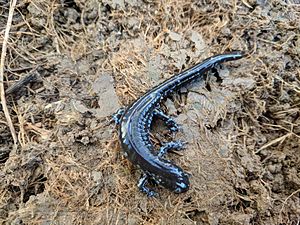Blue-spotted salamander facts for kids
Quick facts for kids Blue-spotted salamander |
|
|---|---|
 |
|
| Conservation status | |
| Scientific classification | |
| Genus: |
Ambystoma
|
| Species: |
laterale
|
The blue-spotted salamander (Ambystoma laterale) is a type of mole salamander. It lives in the Great Lakes states and the northeastern United States. You can also find it in parts of Ontario and Quebec in Canada. Its home range stretches north to James Bay and west to southeastern Manitoba.
Contents
What Does a Blue-Spotted Salamander Look Like?
Blue-spotted salamanders are usually about 10 to 14 centimeters (4 to 5.5 inches) long. Their tail makes up about 40% of their total length. Their skin is a bluish-black color. They have cool blue and white spots on their back. Their sides and tail also have bluish-white spots.
They have a long, slender body. The area near their tail, called the vent, is usually black. This color stands out against their lighter belly. Young salamanders that have just moved to land might have yellow spots. These spots turn blue as they grow. Sometimes, you might even find a completely black salamander.
These salamanders have long toes. They have four toes on their front feet and five on their back feet. Most of them have 12 to 14 special grooves on their sides called costal grooves. Male salamanders are usually smaller than females. However, males often have longer, flatter tails.
Where Do Blue-Spotted Salamanders Live?
Blue-spotted salamanders mostly live in wet deciduous hardwood forests. They also like swampy woodlands. Sometimes, you can find them in pine forests or open fields. They really like vernal pools. These are temporary ponds that hold water until mid-summer. This helps them have a good place to lay their eggs.
They use things like underbrush, fallen leaves, rocks, and logs for shelter. Scientists are learning that things like light pollution might also affect where they choose to live.
Blue-Spotted Salamander Life Cycle and Reproduction
Blue-spotted salamanders breed in early spring. They usually go to vernal pools to lay their eggs. Females lay their eggs in small groups. They attach these groups to twigs, rocks, or plants near the edge of a pond or ditch. Each group usually has about a dozen eggs. A female can lay up to 500 eggs in a year! Both males and females start mating when they are two years old.
The eggs take about one month to hatch. When the larvae (baby salamanders) hatch, they have a mouth and eyes that are ready to go. Their front legs grow in about two weeks. Their back legs appear around three weeks. By late summer, they fully change into their land-dwelling form.
Blue-spotted salamanders are special because they are linked to all-female salamander groups. These all-female salamanders often look like blue-spotted salamanders. But they have a mix of genes from different species. They need sperm from a male salamander to start their eggs developing. Usually, the egg then gets rid of the male's genes and develops on its own. This is like a special type of cloning. Sometimes, though, the egg might actually use the male's genes. This can make the offspring have more sets of genes. This unique way of reproducing is called kleptogenesis.
How Do They Relate to Tremblay's Salamander?
Female Tremblay's salamanders (Ambystoma tremblayi) also breed with male blue-spotted salamanders. This happens from March to April. The Tremblay's salamander eggs are laid one by one or in small groups of 6 to 10 eggs. They are usually found on debris at the bottom of a pond. In this case, the male's genes only help the egg start developing. The male's genetic material is not actually used in the baby salamander.



